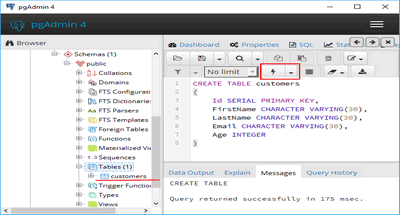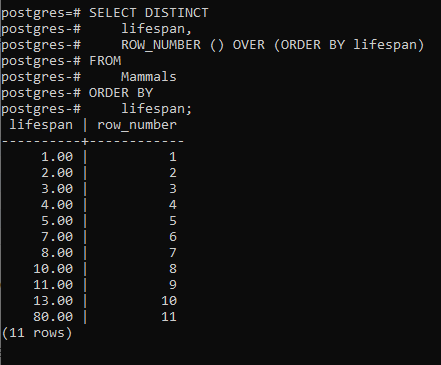

Some browsers use the current DST (Daylight Saving Time) rules for all dates in history. Please note: All tools on this page are based on the date & time settings of your computer and use JavaScript to convert times. More date related programming examples: What's the current week number? - What's the current day number? Thanks to everyone who sent me corrections and updates!
#POSTGRESQL COUNT WINDOWS#
Works for Windows PowerShell v1 and v2Ĭommand line: perl -e "print scalar(localtime( epoch))" (If Perl is installed) Replace 'localtime' with 'gmtime' for GMT/UTC time. Math.floor(new Date().getTime()/1000.0) The getTime method returns the time in milliseconds.ĭATETIME() -, then use: get-epochDate 1520000000. SELECT dbinfo('utc_current') FROM sysmaster:sysdual SELECT (CAST(SYS_EXTRACT_UTC(SYSTIMESTAMP) AS DATE) - TO_DATE('','DD/MM/YYYY')) * 24 * 60 * 60 FROM DUAL SELECT unix_timestamp(now()) More MySQL examples

(version 18+), older versions: calendar:datetime_to_gregorian_seconds(calendar:universal_time())-719528*24*3600. timeIntervalSince1970] (returns double) or NSString *currentTimestamp = timeIntervalSince1970]] ĭouble now = std::chrono::duration_cast(std::chrono::system_clock::now().time_since_epoch()).count() Įpoch := DateTimetoUnix(Now) Tested in Delphi 2010.Įrlang:system_time(seconds). Long epoch = System.currentTimeMillis()/1000 Returns epoch in seconds.ĭ() (.NET Framework 4.6+/.NET Core), older versions: var epoch = (DateTime.UtcNow - new DateTime(1970, 1, 1, 0, 0, 0, DateTimeKind.Utc)).TotalSeconds Postgres will optimize it.How to get the current epoch time in. HAVING MAX(b.limit_call) > COUNT(a.log_id)Īnd don't care about duplicating COUNT(a.log_id) expression in the first and in the last lines. JOIN "License" b ON(a.license_id=b.license_id) For example, in your case, you can use MAX: SELECT COUNT(a.log_id) AS overall_count But you can use an agregate function to map many "limit_calls" in the group into a single value. NOTE: you cannot use HAVING b.limit_call >. can add as many count(*) columns as you needįilter-out the groups, having condition mismatch:.get 0 for groups where the condition never meets.Pure conditional count(*): SELECT COUNT(*) FILTER(where a.myfield > 0) AS my_count The having clause is similar to the where clause, except that it deals with columns after an aggregation, whereas the where clause works on columns before an aggregation.Īlso, is there a reason why your table names are enclosed in double quotes? The main clauses of a SELECT statement in PostgreSQL are written in the following order: WITH SELECT FROM JOIN WHERE GROUP BY HAVING WINDOW ORDER BY OFFSET LIMIT If the query includes CTEs, then the WITH clause comes before the other ones. The where query doesn't recognize your column alias, and furthermore, you're trying to filter out rows after aggregation. If you don't mind to get a count of 1 for 0 rows in the left table, use that.Īside: I would advise not to use mixed case identifiers in Postgres if possible. This column is used in the join, so we don't have to bother whether the column can be null or not.Ĭount(*) is even shorter and slightly faster, yet. Since you want to count related entries in table "Log" it is safer and slightly cheaper to use count(b.license_id). Only non-null values are counted by count(). I used LEFT JOIN instead of JOIN, so you do not exclude licenses without any logs at all. USING is just a notational convenience here. I reversed the order of tables in the FROM clause and cleaned up the syntax a bit to make it less confusing. ORDER BY and GROUP BY clauses, but not in the WHERE or HAVINGĬlauses there you must write out the expression instead. Per documentation:Īn output column's name can be used to refer to the column's value in

Code: SELECT firstname, length ( firstname) AS 'Length of a First Name' FROM employees WHERE length ( firstname)>7 Copy. And you cannot refer to output columns (column aliases) in the HAVING clause, where you can only reference input columns. The example below, returns the firstname and the length of firstname ( how many characters contain in the first name ) from the employees where the length of firstname is more than 7. The condition you had in the WHERE clause has to move to the HAVING clause since it refers to the result of an aggregate function ( after WHERE has been applied). Why can't I exclude dependent columns from `GROUP BY` when I aggregate by a key?.The release notes for 9.1:Īllow non- GROUP BY columns in the query target list when the primary In older versions you'd have to add a.limit_call to the GROUP BY list. Since Postgres 9.1 the primary key covers all columns of a table in the GROUP BY clause. HAVING a.limit_call > count(b.license_id) GROUP BY a.license_id -, a.limit_call - add in old versions PostgreSQL COUNT function is the simplest function and very useful in counting the number of records, which are expected to be returned by a SELECT statement.


 0 kommentar(er)
0 kommentar(er)
